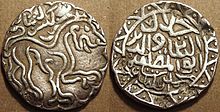Jalaluddin Muhammad Shah
| Jalaluddin Muhammad Shah | |
|---|---|
| Sultan, Amir and Caliph | |

Arabic silver coin with a lion inscription minted during Jalaluddin Muhammad Shah's reign
|
|
| Sultan of Bengal | |
| Reign | 1415–1416 1418–1433 |
| Predecessor |
Shihabuddin Bayazid Shah Raja Ganesha (1416–1418) |
| Successor |
Raja Ganesha (1416–1418) Shamsuddin Ahmad Shah |
Jalaluddin Muhammad Shah (Bengali: জালালউদ্দীন মুহম্মদ শাহ; born as Yadu or Jadu) was a 15th-century Sultan of Bengal and an important figure in medieval Bengali history. Born a Hindu to his aristocratic father Raja Ganesha, he assumed the throne of Bengal after a coup which overthrew the Ilyas Shahi dynasty. He converted to Islam and ruled the Bengal Sultanate for 16 years. As a Muslim king, he brought Arakan under Bengali suzerainty and consolidated the kingdom's domestic administrative centres. He pursued relations with the Timurid Empire, Mamluk Egypt and Ming China. Bengal grew in wealth and population during his reign. He also combined Bengali and Islamic architecture.
According to Goron and Goenka, Raja Ganesha seized control over Bengal soon after the death of Sultan Bayazid (1412–1414). Facing an imminent threat of invasion at the behest of a powerful Muslim holy man named Qutb al Alam, he appealed to the saint to call off his threat. The saint agreed on the condition that Raja Ganesha's son Jadu would convert to Islam and rule in his place. Raja Ganesha agreed and Jadu started ruling Bengal as Jalal al-Din in 1415 AD. Nur Qutb died in 1416 AD and Raja Ganesha was emboldened to depose his son and accede to the throne himself as Danujamarddana Deva. Jalaluddin was reconverted to Hinduism by the Golden Cow ritual. After the death of his father he once again converted to Islam and started ruling his second phase.
Jalaluddin maintained a peaceful kingdom during his second phase. His authority stretched to eastern Bengal Moazzamabad (present-day Sunamganj) and south-eastern Bengal (present-day Chittagong). He also conquered Fathabad (present-day Faridpur) and the southern Bengal. During his reign Firuzabad Pandua became a populous and flourshing town. It is recorded in the Ming shi that a Chinese explorer, Cheng Ho, visited the city twice in 1421–22 and 1431–33. He later transferred the capital from Pandua to Gaur. The city of Gaur began to be re-populated during his reign. Jalaluddin himself constructed a number of buildings and sarais there.
...
Wikipedia
